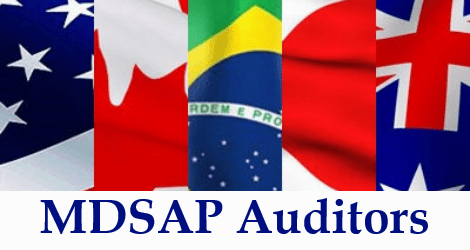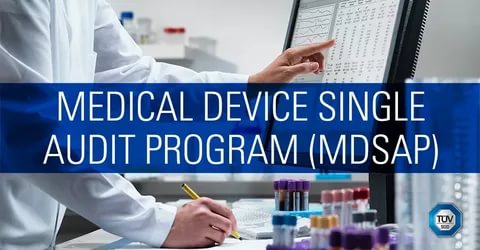MDSAP Certification
1. What is MDSAP certification?
Medical device single audit program (MDSAP) is a set of medical device audit procedures recognized and joined by regulatory agencies in the US (FDA), Australia (TGA), Brazil (ANVISA), Canada (HC), and Japan (MHLW).

This program aims to establish a single audit process, meet and unify the audit requirements of the abovementioned countries, and make the audit more comprehensive and effective. The regulatory agencies of the abovementioned five countries recognize the MDSAP audit results, and the number of audits for the manufacturers by different corresponding regulatory agencies can be reduced, thereby reducing the production interference caused by the audits. It was officially implemented from January 2017.
2. Who will make the MDSAP certification?
The medical device manufacturer will contact a third-party notified body (such as SGS, BSI and TUV) for the MDSAP audit, and the medical device regulatory authorities of the participating countries (five countries: the US, Australia, Brazil, Canada and Japan) may take the audit report as the basis for judgment.?For the auditing organizations (AO) with the MDSAP audit qualification, click the following link: https://www.fda.gov/media/137394/download
3. Who recognizes the MDSAP certification?
The recognition levels of the five participating countries are as follows:
US: the FDA’s routine inspection can be replaced (except the FDA’s special inspection and the PMA products);
Brazil: for Class III and Class IV medical devices, the ANVISA’s pre-market GMP inspection and the post-market routine inspection can be replaced (except the special inspection);
Japan: for Class II, Class III and Class IV medical devices, the on-site factory audit can be exempted;
Canada: Since 2019, the MDSAP certificate has replaced the original CMDCAS certificate, as the only valid certificate that proves the compliance of the quality management system when products of Class II and above enter the Canadian market;
Australia: the TGA audit is exempted, supporting the issuance and maintenance of the TGA conformity audit certificate

4. MDSAP certification process
1)The enterprise recognizes the MDSAP regulations and establishes a quality management system that meets the MDSAP requirements;
2)The enterprise submits a certification application to the auditing organization (AO) and signs a certification contract;
3)The auditing organization (AO) goes to the enterprise’s premise to conduct an audit;
4)The enterprise makes rectification according to the rectification items proposed by the auditing organization (AO) and submits the rectification plan;
5)The auditing organization (AO) audits the rectification by the enterprise;
6) After the audit is passed, the auditing organization (AO) issues an MDSAP certificate.
5. As a global technical service provider that is professional in the field of medical device regulations, SUNGO can provide the following services:
1) MDSAP special training service;
2) Counsel the enterprise on establishing a quality management system that meets the MDSAP requirements;
3) Analyze the gap between the existing system and the regulatory requirements;
4) Simulate the audit to help the enterprise identify the weak links;
5) Accompany the on-site audit;
6) Counsel the enterprise on conducting the rectification after the audit and make replies on the rectification.
6. SUNGO service process:
|
Process |
Task |
Division of work |
Cycle |
|
1 |
Obtaining an overall understanding; determining the MDSAP regulations; formulating an overall counseling plan |
Sungo takes the charge The enterprise assists in the confirmation |
5 working days |
|
2 |
Evaluating the current status of the management system on site and analyzing the gap between the existing system and the regulatory requirements |
Sungo is responsible for the implementation The enterprise provides the cooperation |
2-3 working days |
|
3 |
Training on standards and regulations |
Sungo is responsible for the implementation The enterprise participates in the training |
1~2 working days |
|
4 |
Assisting and guiding the enterprise in completing the quality manuals and procedure documents |
The enterprise is responsible for the implementation Sungo provides the guidance |
1-2 months |
|
5 |
Guiding the enterprise in completing the Level III and Level IV documents |
The enterprise is responsible for the implementation Sungo provides the guidance |
1-2 months |
|
6 |
Checking the problems in each module of the management system and correcting them |
Sungo is responsible for the inspection The enterprise makes the rectification |
About 1 week |
|
7 |
Guiding the enterprise in completing the internal audit and management review |
The enterprise is responsible for the implementation Sungo provides the guidance |
About 1 week |
|
8 |
Checking the rectification of the gaps |
Sungo is responsible for the inspection The enterprise makes the rectification |
About 2 weeks |
|
9 |
Simulating the audit |
Sungo |
2-3 working days |
|
10 |
Accompanying the on-site audit |
Enterprise & Sungo |
Depending on the actual situation |
|
11 |
Problem rectification and response after the audit |
The enterprise is responsible for the implementation Sungo provides the guidance |
Plan submission: 15 working days The implementation of rectification depends on the specific situation |
|
12 |
The audit is passed and the certificate is issued |
AO |
Depending on the actual situation |
